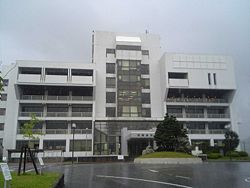|
Kamogawa, Chiba
  Kamogawa (鴨川市, Kamogawa-shi) is a city located in Chiba Prefecture, Japan.[1] As of 1 December 2020[update], the city had an estimated population of 31,722 in 14,558 households and a population density of 170 persons per km2.[2] The total area of the city is 191.14 square kilometers (73.80 sq mi). The name of the city consists of two kanji characters: the first, kamo (鴨), meaning "duck", and the second, kawa (川), meaning "river".[3] GeographyKamogawa is near the southeastern tip of the Bōsō Peninsula, facing the North Pacific Ocean, about 50 km south of the prefectural capital, Chiba, and about 85 km from the capital of Japan, Tokyo. Kamogawa is home to Mount Atago, which at 408.2 m (1,339 ft) is the highest point in Chiba Prefecture.[4] Mount Kiyosumi (337 m (1,106 ft)) is home to Seichō-ji. The Kamo River (22.25 kilometers (13.83 mi)) empties into the Pacific Ocean at Kamogawa.[5] Neighboring municipalitiesChiba Prefecture ClimateKamogawa has a humid subtropical climate (Köppen Cfa) characterized by warm summers and cool winters with light to no snowfall. The average annual temperature in Kamogawa is 15.5 °C. The average annual rainfall is 1833 mm with September as the wettest month. The temperatures are highest on average in August, at around 26.0 °C, and lowest in January, at around 5.9 °C.[6]
DemographicsPer Japanese census data,[9] the population of Kamogawa has been gradually decreasing over the past 70 years.
HistoryEarly historyThe area of present-day Kamogawa was part of ancient Awa Province. Nichiren (1222 – 1282) was born in the Kominato district of Kamogawa, and his birthplace is commemorated at Tanjō-ji.[10] During the Edo period, it was mostly tenryō territory controlled directly by the Tokugawa shogunate, with portions under the control of the feudal domains of Funagata Domain, Tateyama Domain, Iwasuki Domain and Tsurumaki Domain.[3] The short-lived (1638-1690) Tōjō Domain and the Bakumatsu period Hanabusa Domain were also located within the borders of modern Kamogawa. Modern historyIn 1877, Kamogawa suffered a notable cholera outbreak. At the start of the Meiji period, Kamogawa consisted of all of Nagasa District with two towns and nine villages, and two villages from neighboring Asai District. All of these villages and towns (including Kamogawa Town) became part of Awa District in 1890. In 1927 Awa-Kamogawa Station became the terminus of both the Sotobō Line and the Uchibō Line.[3] The city sustained injuries and fatalities during World War II via aerial bombing by the United States. The city was occupied by American forces after the war. Soon after, land reform and economic reform were carried out in Kamogawa. In 1958 the coastal areas of Kamogawa became a part of Minami Bōsō Quasi-National Park, and the town became a tourist destination as a result of the establishment of the park. Kamogawa was elevated to city status on March 31, 1971. On February 11, 2005, the town of Amatsukominato (from Awa District) was merged into Kamogawa. GovernmentKamogawa has a mayor-council form of government with a directly elected mayor and a unicameral city council of 18 members. Kamogawa contributes one member to the Chiba Prefectural Assembly. In terms of national politics, the city is part of Chiba 12th district of the lower house of the Diet of Japan. EconomyKamogawa serves as a commercial center for the surrounding region of south-central Chiba Prefecture. Commercial fishing remains the primary industry in Kamogawa, which has five active fishing ports. The city is noted for its sardine and mackerel production. Rice farming and floriculture are practiced.[3] The tourist industry is a growing component of the local economy, with visitors attracted to the area's beaches, hot spring resorts, Kamogawa Seaworld, and the Futomi Flower Center. TransportationRailway
HighwayEducation
Sister cities
Local attractions
Noted people from Kamogawa
Cultural referencesThe anime series Lagrange: The Flower of Rin-ne is set in Kamogawa. References
External linksWikimedia Commons has media related to Kamogawa, Chiba.
|
|||||||||||||||||||||||||||||||||||||||||||||||||||||||||||||||||||||||||||||||||||||||||||||||||||||||||||||||||||||||||||||||||||||||||||||||||||||||||||||||||||||||||||||||||||||||||||||||||||||||||||||||||||||||||||||||||||||||||||||||||
![View from Uomizuka Tower Kamogawa Sea World Niemonjima Oyama Rice Terraces Kamogawa Grand Hotel Kamogawa Grand Tower Seichō-ji Kameda General Hospital]](http://upload.wikimedia.org/wikipedia/commons/thumb/0/04/Kamogawa_Montage.jpg/250px-Kamogawa_Montage.jpg)



